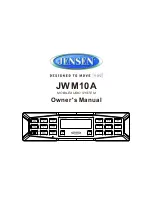
SCM200/300ASL/P4
7 . C o n n e c t i n g
The P4 rear panel carries the mains inlet and signal input socket, mains isolation
switch, a remote control interface and fuse holder. Each feature is described below.
4.1
Mains Inlet:
The supplied mains power lead (appropriate to the local territory)
should be connected here. Ensure that the mains voltage specified on the panel
corresponds with the local supply.
4.2
Power Switch:
Connects the unit to mains power.
4.3
Fuseholder:
Should a P4 fail to respond when the power-up sequence is initiated
the fuse should be inspected. Lift out the fuseholder cover using a small flat-blade
screwdriver, remove the fuse and inspect it for damage. A replacement fuse
should be fitted if required. It should be stressed however that fuses most often
fail only because of a serious electrical fault. If this is the case then simply
replacing the fuse will only result in another fuse failure.The monitor should be
returned to ATC if a second fuse fails.
4.4
Input Socket:
The audio signal cable should be connected here. Balanced or
unbalanced cables may be used (See Section 6).
4.5
Remote Control Interface:
Active and standby status of the P4 can be controlled
via the 5-pin interface socket. ATC does not manufacture a remote control
product for the P4 however the electronic and logic characteristics of the
interface are such that it may easily be integrated into typical studio automation
schemes. The interface pin specification is as follows. The pins are identified in
Diagram 5
Pin 1.
0 Volts / logic ground.
Pin 2.
Standby/active mode toggled by momentary grounding.
Pin 3.
+ 5 Volts when the P4 is in normal active condition.
Pin 4.
+ 5V when the P4 is in standby.
Pin 5.
+ 5 Volts on any error including drive limit.
Note: Pins 3,4 and 5 have a series resistance of 240 Ohms and allow sensing or
drive of LED’s only.
5
O p e r a t i o n
Diagram 5 - remote interface
Pin
Connection
1
0 Volt
2
Standby - control
3
Powered up - out
4
Standby - out
5
Error - out
8 . S t a r t U p
Once the P4 and monitors are installed and all
connections are made the system can be switched
on. Switch-on should be carried out for each P4
separately. First, the mains isolation switch on the
rear of each P4 should be switched to the ON
position.
Then, to activate the P4 press the front panel
standby button once. This begins a power-up
sequence, the progress of which is revealed by
colour and state changes in the two front panel
indicators:
1. STANDBY
button pressed
2. GREEN
indicator turns to
ORANGE.
3. BLUE
indicator starts flashing (self checks in
progress)
4.
ORANGE
indicator turns to
RED
(mute
circuit released).
5.
RED
indicator extinguishes.
6.
BLUE
indicator switches to constant (normal
operation).
Any failure in the power-up sequence will be
indicated by a steady ORANGE indicator. If there
is no obvious cause for a power-up failure (high
heatsink temperature, or output wiring fault for
example) the P4 should be returned to ATC for
service. Any other fault condition will cause the
amplifier to shutdown and the ORANGE indicator
to light.
During normal operation the BLUE indicator will
remain lit. If the amplifier is being driven hard an
occasional RED indicator reveals operation of the
gain reduction circuits.
If a fault has occurred causing the P4 to shutdown
is may be possible to restart by pressing the
standby button. If the shutdown was due to
excessive temperature rise the unit will have to be
left to cool before a restart.
The amplifier can be returned to standby by
pressing the standby button, the blue LED will
extinguish and only a green LED will be displayed.
1
2
3
4
5



























